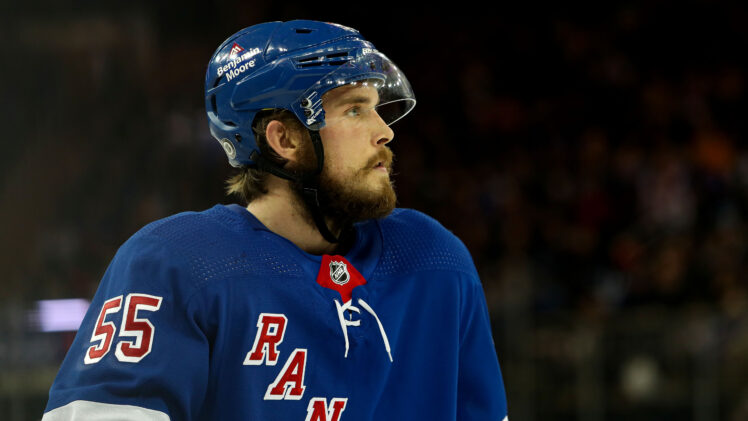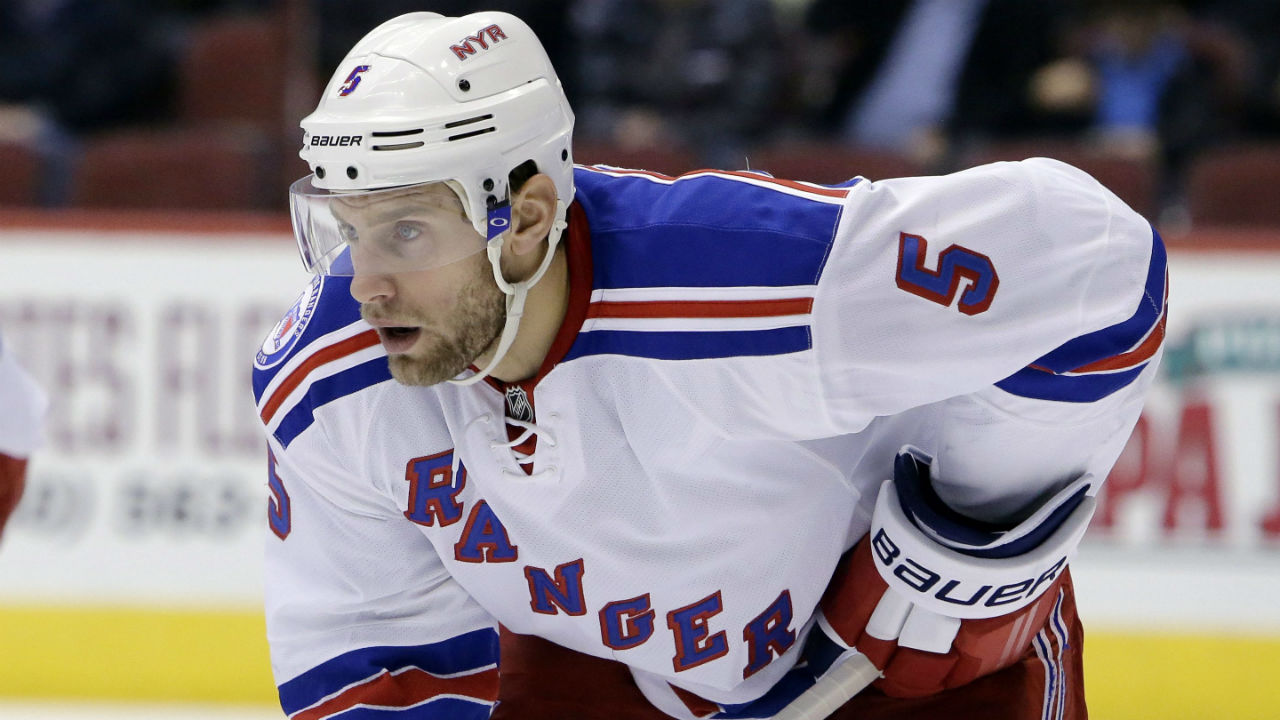When presented with such accolades, it’s undeniable that Ryan Lindgren epitomizes them all. As a defenseman for the Blueshirts, he embodies toughness, resilience, and unwavering dedication. Despite enduring frequent pain and physicality on the ice, often alongside Adam Fox, Lindgren consistently rebounds and returns to action, showcasing his grit and determination. His ability to seamlessly resume his role as the team’s gritty stalwart after taking hits highlights his status as a true NHL throwback player.
Lindgren’s toughness is unparalleled, and there’s no question that his unwavering dedication and resilience serve as a source of inspiration for the Rangers. His ability to push through injuries and give his all for the team every night is admirable and undoubtedly appreciated by his teammates. However, while Lindgren embodies the determined, salt-of-the-earth spirit that the organization values, there’s a risk that focusing solely on players like him could lead the team down a path reminiscent of a decade ago, where results were less than satisfactory, if not outright disastrous.
Lindgren and Girardi Come With Near-Identical Long-Term Risks

The similarities between Lindgren and Dan Girardi are striking, though not exact. Girardi embodied the same selfless commitment to sacrificing his body, whether it was blocking shots, engaging in physical battles along the boards and in front of the net, or absorbing hits from larger opponents. Like Lindgren, Girardi demonstrated a remarkable pain tolerance, exemplified by his courageous play in the 2015 Eastern Conference Final despite a Grade 1 MCL sprain. Throughout his career, Girardi consistently answered the call, playing 80 or more games in a season seven times, showcasing his durability and unwavering dedication to his team.

The hockey DNA of both players is remarkably similar. Despite being somewhat undersized and initially overlooked prospects, Girardi and Lindgren share a story of perseverance and determination. Girardi went undrafted in 2003 before earning a spot with the Rangers through a training-camp invite in 2005. Similarly, Lindgren, drafted in the second round by the Boston Bruins in 2016, was initially seen as a depth player and later became part of the Rick Nash deadline trade in 2018.
Both players defied expectations and proved their worth through their heart and determination, qualities that defy the cold analytical approach prevalent in modern sports procurement. They emerged as key contributors to winning teams that were contenders for the Stanley Cup, demonstrating that intangible characteristics can be just as valuable as measurable skills in the pursuit of success.
However, those cold analytics that can’t measure the size of the fight in the dog proved correct when they raised red flags about the wisdom of giving Girardi a contract extension in 2014, and some of the same warning signs are emerging with Lindgren, who will become a restricted free agent with arbitration rights on July 1.
The Rangers face the potential danger of letting their appreciation for Lindgren’s on-ice contributions influence their decision-making regarding whether to maintain their relationship with him. This scenario closely mirrors what occurred nearly a decade ago with Dan Girardi, who was approaching unrestricted free agency at the time. General Manager Glen Sather, despite not being at the forefront of the emerging analytics revolution in sports, took a tough stance with Girardi, indicating that pending free agents unwilling to agree to team-friendly extensions during the season would be subject to trade.
This history serves as a cautionary tale, highlighting the potential pitfalls of allowing sentimentality to override strategic decision-making, especially in the context of contract negotiations and roster management.
Girardi and the Rangers ultimately reached an agreement, securing a six-year, $33 million contract on February 28, 2014. However, this resolution was swiftly followed by a clear demonstration from Sather that his earlier stance had not been an idle threat. Just one week later, Sather made a bold move by trading captain Ryan Callahan to the Tampa Bay Lightning in a surprising and significant transaction. This sequence of events underscored Sather’s commitment to his principles and his willingness to make tough decisions in the interest of the team’s long-term success, even if it meant parting ways with beloved players.
Despite initial intentions for Girardi’s contract to be team-friendly, it ultimately proved to be anything but. Although Girardi managed to play all 82 games for the Presidents’ Trophy-winning Rangers in the 2014-15 season, his performance gradually declined thereafter. Persistent injuries accumulated over the years appeared to take their toll, especially in a league that was evolving towards faster play, an area where Girardi wasn’t known for his prowess. Three years into the contract, Jeff Gorton, who had succeeded Sather as general manager, made the decision to execute a costly buyout after the 2016-17 season. This move left the Rangers with six years of dead salary-cap charges, which only concluded after the most recent season, highlighting the long-lasting financial repercussions of the deal.
The error in re-signing Girardi stemmed from a failure to look beyond his admirable human qualities as a great teammate, hard worker, and devoted Ranger, and to instead assess his on-ice performance objectively. Girardi was frequently paired with Ryan McDonagh on the Rangers’ presumed top defensive pair, a placement that, in hindsight, wasn’t suitable for his abilities. This oversight underscores the importance of evaluating players based on their skill set and performance rather than solely relying on intangible qualities such as loyalty and team spirit.
Rangers Must Put Sentiment Aside With Lindgren and Look
Indeed, the statistical metrics reveal that Girardi frequently struggled on the ice and didn’t contribute positively to possession metrics. His Corsi for numbers failed to surpass 50 percent after his second season and plummeted to 37.3 during the 2015-16 season. Particularly concerning were his difficulties during the 2014 postseason, where his diminishing mobility was consistently exploited by opponents. These struggles raised significant red flags, especially considering that Girardi was on the verge of embarking on a six-year contract extension the following season.
Compounding the situation, the Rangers had discovered an undervalued talent in Anton Stralman, who, like Girardi, played as a right-side defenseman. Stralman joined the team as an inexpensive free agent before the 2011-12 season and consistently delivered exceptional possession numbers throughout his three seasons with the Blueshirts. During the 2014 playoffs, it was Stralman and Marc Staal who assumed the mantle of the matchup defense pair when Girardi’s effectiveness waned, leaving coach Alain Vigneault with few alternatives. This shift underscored the stark contrast in performance between Girardi and Stralman during crucial moments.
Stralman played a crucial role in the Rangers’ journey to the Stanley Cup Final and showcased his value with exceptional performances. However, despite his contributions, the Rangers allowed Stralman to depart after that season. He subsequently signed a five-year contract with the Lightning, reportedly due to a relatively minor difference in negotiations.
In hindsight, the lesson is clear: Stralman, while perhaps less flashy than Girardi, was undeniably more effective, as evidenced by his strong underlying numbers. His departure and subsequent success in Tampa Bay underscore the significant impact of roster decisions on a team’s performance. Allowing Stralman to walk, particularly after committing to Girardi with a less favorable contract, had long-term implications for the Rangers’ defense.
Returning to Lindgren’s situation, there are parallels that can be drawn from the Girardi episode, although they are not identical. Lindgren, currently concluding a three-year, $9 million bridge deal, faces a crucial juncture in his career trajectory. Unlike Girardi, Lindgren is three years younger at the time of his potential free agency, which could influence contract negotiations and future decisions.
Furthermore, one aspect often overlooked in Lindgren’s game is his skating ability, which has proven to be underrated and a key factor in his success in the NHL. This distinction sets Lindgren apart from Girardi and could impact the evaluation of his long-term potential and value to the Rangers. Therefore, while there are lessons to be learned from the Girardi episode, Lindgren’s unique attributes and circumstances warrant careful consideration in any future contract discussions.
Certainly, the comparison between Lindgren and Girardi raises valid concerns about the potential trajectory of Lindgren’s career. Girardi’s relentless style of play eventually took a toll on his body, leading to nagging injuries that diminished his effectiveness over time. This raises questions about whether Lindgren, with a similar aggressive playing style, may face similar challenges as he ages. Will he be able to continue bouncing back from big hits into his 30s, particularly if he signs a long-term contract?
Moreover, the availability of more extensive data in today’s NHL landscape provides a clearer picture of a player’s impact. While Lindgren’s career Corsi for of 45.2 may be viewed as somewhat outdated, other advanced metrics also suggest areas of concern regarding his overall impact on the ice. These statistics raise important considerations for the Rangers as they evaluate Lindgren’s long-term potential and weigh the implications of any future contract negotiations.





